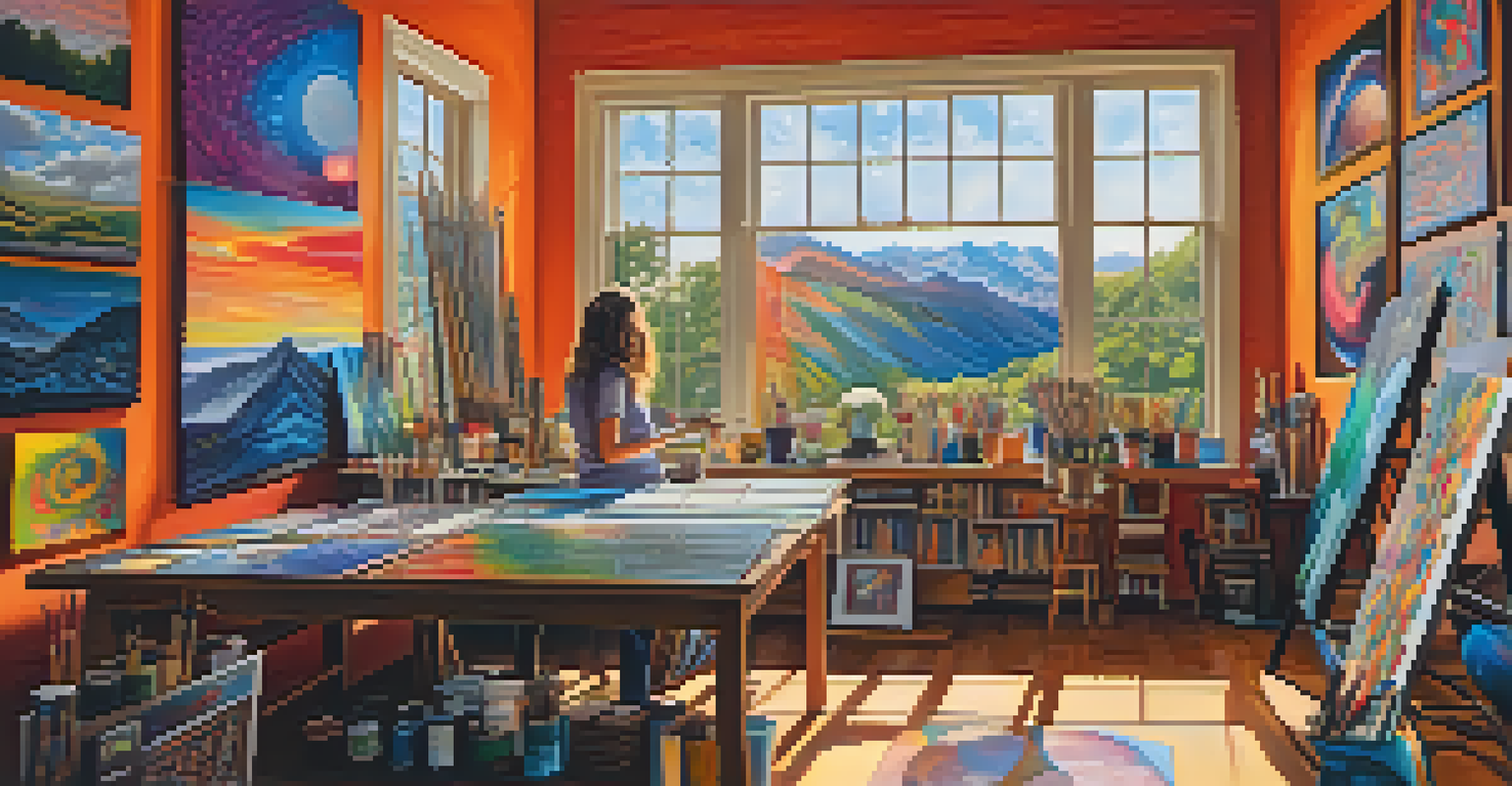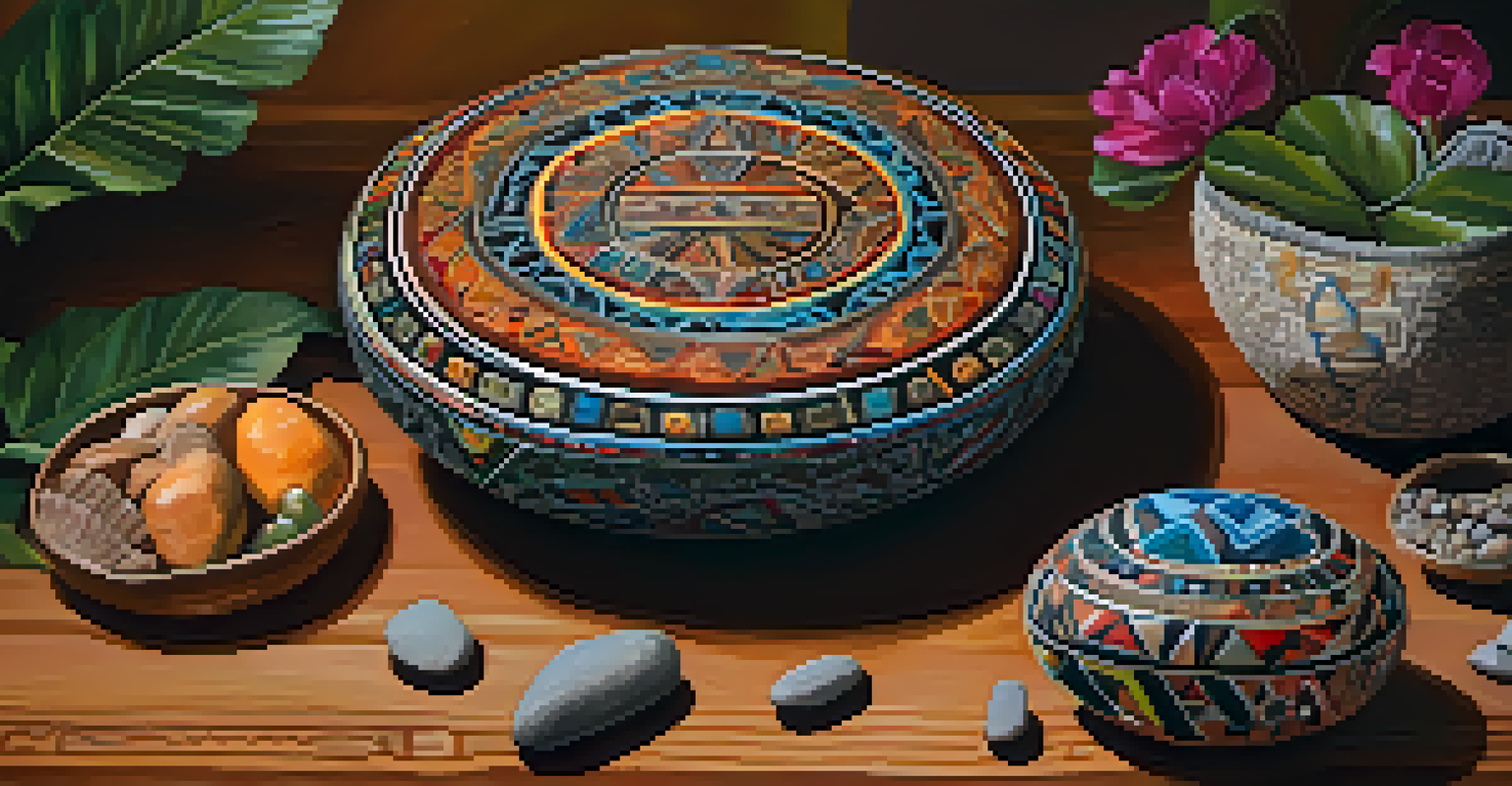Entheogens and Visual Arts: Unlocking New Dimensions of Expression

What are Entheogens? A Brief Overview
Entheogens are substances that are often used in spiritual or religious contexts to enhance consciousness and facilitate deeper introspection. These can include natural plants like psilocybin mushrooms or synthetic compounds like LSD. Historically, various cultures have employed these substances to connect with the divine or to explore the inner workings of the mind.
Psychedelics are a catalyst for creativity, helping artists transcend the ordinary and explore the depths of their imagination.
The name 'entheogen' comes from the Greek words meaning 'generating the divine within.' This highlights the transformative experience such substances can offer, enabling individuals to see the world in a new light. It's not merely about altering perception; it's about expanding one's understanding of existence and creativity.
As artists often seek new ways to express complex emotions and ideas, entheogens can serve as powerful tools for inspiration. By tapping into altered states of consciousness, artists frequently discover fresh perspectives that influence their work and creative process.
The Intersection of Entheogens and Creativity
Many artists have historically turned to entheogens to unlock their creative potential. The vivid imagery and emotional depth often perceived during these experiences can lead to groundbreaking artistic expressions. For example, renowned artists like Vincent van Gogh and Salvador Dalí have been speculated to have used substances that altered their perception of reality.

The relationship between altered states and creativity isn't merely anecdotal. Studies suggest that entheogens can enhance divergent thinking—a key component of creativity where individuals generate multiple solutions to a problem. This shift in thought patterns can lead to innovative artistic techniques and styles.
Entheogens Enhance Creativity
Entheogens have historically been used by artists to unlock creative potential and inspire innovative expressions.
Moreover, the use of entheogens can dissolve the boundaries between the self and the external world, fostering a sense of interconnectedness. This feeling often translates into art, as artists reflect universal themes that resonate deeply with viewers, bridging personal experiences with collective human emotions.
Historical Context of Entheogens in Art
Throughout history, various cultures have integrated entheogens into their artistic practices. For instance, Indigenous peoples in the Americas have long used peyote and ayahuasca not only for spiritual ceremonies but also for artistic expression. The vibrant colors and intricate designs in their crafts often reflect the profound experiences induced by these substances.
Art is the most beautiful of all lies; it reveals the truth of our inner experience.
In ancient Greece, the Eleusinian Mysteries involved the consumption of a sacred drink thought to contain ergot, a precursor to LSD. Participants would experience visions that inspired philosophical and artistic pursuits, leaving a lasting impact on Western art and thought. This historical interplay emphasizes the long-standing connection between psychedelics and creativity.
Even in modern times, the resurgence of interest in entheogens has led to new artistic movements. Contemporary artists continue to draw inspiration from their experiences with these substances, creating works that challenge conventional aesthetics and provoke thought about altered states of consciousness.
Entheogens and Modern Visual Arts
Today, many visual artists are openly exploring the use of entheogens as a means to enhance their creative processes. From painters to digital artists, a growing number are documenting their experiences through their work, often resulting in bold and transformative pieces. These creations invite viewers to experience the artist's journey and the emotions tied to these altered states.
Modern visual arts have also seen the rise of psychedelic art, which draws directly from the visual experiences associated with entheogen use. This genre often features vivid colors, intricate patterns, and surreal landscapes that mirror the hallucinatory effects of psychedelics. As more artists embrace these themes, they contribute to a broader cultural conversation around the nature of reality and perception.
Therapeutic Benefits of Entheogens
Recent studies suggest that entheogens can provide emotional breakthroughs, helping artists confront trauma and enhance their work.
Social media platforms have further amplified this movement, allowing artists to share their entheogen-inspired works with a global audience. This accessibility fosters a community that celebrates the intersection of mental exploration and artistic expression, encouraging dialogue about the role of psychedelics in creativity.
The Therapeutic Benefits of Entheogens
Recent studies have highlighted the therapeutic potential of entheogens, particularly in treating mental health conditions such as depression and anxiety. These substances can facilitate profound emotional breakthroughs, allowing individuals to confront and heal from trauma. As artists often channel their experiences into their work, this therapeutic aspect can lead to deeply resonant art.
The cathartic release experienced during entheogenic sessions may enhance an artist's ability to express complex emotions and narratives. This process can lead to art that not only captivates viewers but also serves as a healing tool for the artist. The act of creation becomes intertwined with personal growth and emotional exploration.
Furthermore, the acceptance of entheogens in therapeutic contexts could reshape societal views on their use in the arts. As more professionals advocate for their benefits, artists may feel empowered to explore these substances without stigma, ultimately enriching the artistic landscape with their newfound insights.
Navigating the Ethical Considerations
While the relationship between entheogens and visual arts can be deeply enriching, it also raises ethical questions. For instance, the commodification of indigenous practices and substances can lead to cultural appropriation, stripping these traditions of their spiritual significance. Artists must be mindful of the origins and meanings behind the substances they use to avoid disrespecting those cultures.
Additionally, the use of entheogens should be approached with caution and respect. Not all experiences are positive, and the potential for psychological distress exists, especially without proper guidance. Artists and creators should prioritize safety and consider the context in which they engage with these substances.
Ethical Use in Artistic Expression
The use of entheogens in art raises ethical concerns, emphasizing the need for respect towards indigenous practices and safety in experiences.
Engaging with entheogens ethically means fostering a respectful dialogue about their use in art. This includes recognizing the importance of mental health support and the need for responsible practices. By embracing this approach, artists can contribute to a more thoughtful and inclusive artistic community.
The Future of Entheogens in the Art World
As societal attitudes towards entheogens continue to evolve, we may witness an increasing acceptance of their role in the arts. The decriminalization and legalization of certain substances in various regions signal a shift in perception, opening doors for artists to explore these avenues more freely. This change could lead to a renaissance of creativity fueled by altered states of consciousness.
The potential for collaboration across disciplines is also exciting, as artists, scientists, and mental health professionals come together to study the effects of entheogens on creativity. This interdisciplinary approach could lead to innovative techniques and new forms of artistic expression, enriching the art world as a whole.

Ultimately, the future of entheogens in visual arts will likely be shaped by ongoing research, cultural discussions, and the personal narratives of artists themselves. By continuing to explore this fascinating intersection, we can unlock new dimensions of expression that resonate with the shared human experience.